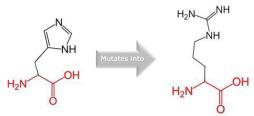Our official English website, www.x-mol.net, welcomes your feedback! (Note: you will need to create a separate account there.)
Mitochondrial genes modulate the phenotypic expression of congenital scoliosis syndrome caused by mutations in the TBXT gene
Gene ( IF 3.5 ) Pub Date : 2024-03-16 , DOI: 10.1016/j.gene.2024.148388 Olfa Alila-Fersi , Amel Tej , Marwa Maalej , Marwa Kharrat , Lamia Boughamoura , Jihen Chouchen , Abdelaziz Tlili , Faiza Fakhfakh
Gene ( IF 3.5 ) Pub Date : 2024-03-16 , DOI: 10.1016/j.gene.2024.148388 Olfa Alila-Fersi , Amel Tej , Marwa Maalej , Marwa Kharrat , Lamia Boughamoura , Jihen Chouchen , Abdelaziz Tlili , Faiza Fakhfakh

|
Congenital scoliosis (CS) is a spinal disorder caused by genetic-congenital vertebral malformations and may be associated with other congenital defects or may occur alone. It is genetically heterogeneous and numerous genes contributing to this disease have been identified. In addition, CS has a wide range of phenotypic and genotypic variability, which has been explained by the intervention of genetic factors like modifiers and environment genes. The aim of the present study was to determine the possible cause of CS in a Tunisian patient and to examine the association between mtDNA mutations and mtDNA content and CS. Here we performed Whole-Exome Sequencing (WES) in a patient presenting clinical features suggestive of severe congenital scoliosis syndrome. Direct sequencing of the whole mitochondrial DNA (mtDNA) was also performed in addition to copy number quantification in the blood of the indexed case. In silico prediction tools, 3D modeling and molecular docking approaches were used. The WES revealed the homozygous missense mutation c.512A > G (p.H171R) in the gene. Bioinformatic analysis demonstrated that the p.H171R variant was highly deleterious and caused the TBXT structure instability. Molecular docking revealed that the p.H171R mutation disrupted the monomer stability which seemed to be crucial for maintaining the stability of the homodimer and consequently to the destabilization of the homodimer-DNA complex. On the other hand, we hypothesized that mtDNA can be a modifier factor, so, the screening of the whole mtDNA showed a novel heteroplasmic m.10150T > A (p.M31K) variation in the gene. Further, qPCR analyses of the patient’s blood excluded mtDNA depletion. Bioinformatic investigation revealed that the p.M31K mutation in the ND3 protein was highly deleterious and may cause the ND3 protein structure destabilization and could disturb the interaction between complex I subunits. We described the possible role of mtDNA genetics on the pathogenesis of congenital scoliosis by hypothesizing that the presence of the homozygous variant in accounts for the CS phenotype in our patient and the gene may act as a modifier gene.
中文翻译:

线粒体基因调节 TBXT 基因突变引起的先天性脊柱侧凸综合征的表型表达
先天性脊柱侧凸(CS)是一种由遗传性先天性椎骨畸形引起的脊柱疾病,可能与其他先天性缺陷相关,也可能单独发生。它具有遗传异质性,并且已鉴定出许多导致这种疾病的基因。此外,CS具有广泛的表型和基因型变异性,这可以通过修饰基因和环境基因等遗传因素的干预来解释。本研究的目的是确定一名突尼斯患者发生 CS 的可能原因,并检查 mtDNA 突变与 mtDNA 含量和 CS 之间的关联。在这里,我们对一名临床特征提示严重先天性脊柱侧弯综合征的患者进行了全外显子组测序(WES)。除了对索引病例血液中的拷贝数进行定量之外,还对整个线粒体 DNA (mtDNA) 进行了直接测序。在计算机预测工具中,使用了 3D 建模和分子对接方法。 WES 显示该基因存在纯合错义突变 c.512A > G (p.H171R)。生物信息学分析表明,p.H171R 变体具有高度有害性,并导致 TBXT 结构不稳定。分子对接显示,p.H171R 突变破坏了单体稳定性,这似乎对于维持同型二聚体的稳定性至关重要,从而导致同型二聚体-DNA 复合物不稳定。另一方面,我们假设mtDNA可以作为修饰因子,因此,对整个mtDNA的筛选显示出该基因中新的异质性m.10150T > A (p.M31K)变异。此外,对患者血液的 qPCR 分析排除了 mtDNA 的缺失。生物信息学研究表明,ND3蛋白中的p.M31K突变是高度有害的,可能导致ND3蛋白结构不稳定,并可能扰乱复合物I亚基之间的相互作用。我们描述了 mtDNA 遗传学在先天性脊柱侧凸发病机制中的可能作用,假设纯合变异体的存在解释了我们患者的 CS 表型,并且该基因可能充当修饰基因。
更新日期:2024-03-16
中文翻译:

线粒体基因调节 TBXT 基因突变引起的先天性脊柱侧凸综合征的表型表达
先天性脊柱侧凸(CS)是一种由遗传性先天性椎骨畸形引起的脊柱疾病,可能与其他先天性缺陷相关,也可能单独发生。它具有遗传异质性,并且已鉴定出许多导致这种疾病的基因。此外,CS具有广泛的表型和基因型变异性,这可以通过修饰基因和环境基因等遗传因素的干预来解释。本研究的目的是确定一名突尼斯患者发生 CS 的可能原因,并检查 mtDNA 突变与 mtDNA 含量和 CS 之间的关联。在这里,我们对一名临床特征提示严重先天性脊柱侧弯综合征的患者进行了全外显子组测序(WES)。除了对索引病例血液中的拷贝数进行定量之外,还对整个线粒体 DNA (mtDNA) 进行了直接测序。在计算机预测工具中,使用了 3D 建模和分子对接方法。 WES 显示该基因存在纯合错义突变 c.512A > G (p.H171R)。生物信息学分析表明,p.H171R 变体具有高度有害性,并导致 TBXT 结构不稳定。分子对接显示,p.H171R 突变破坏了单体稳定性,这似乎对于维持同型二聚体的稳定性至关重要,从而导致同型二聚体-DNA 复合物不稳定。另一方面,我们假设mtDNA可以作为修饰因子,因此,对整个mtDNA的筛选显示出该基因中新的异质性m.10150T > A (p.M31K)变异。此外,对患者血液的 qPCR 分析排除了 mtDNA 的缺失。生物信息学研究表明,ND3蛋白中的p.M31K突变是高度有害的,可能导致ND3蛋白结构不稳定,并可能扰乱复合物I亚基之间的相互作用。我们描述了 mtDNA 遗传学在先天性脊柱侧凸发病机制中的可能作用,假设纯合变异体的存在解释了我们患者的 CS 表型,并且该基因可能充当修饰基因。



























 京公网安备 11010802027423号
京公网安备 11010802027423号